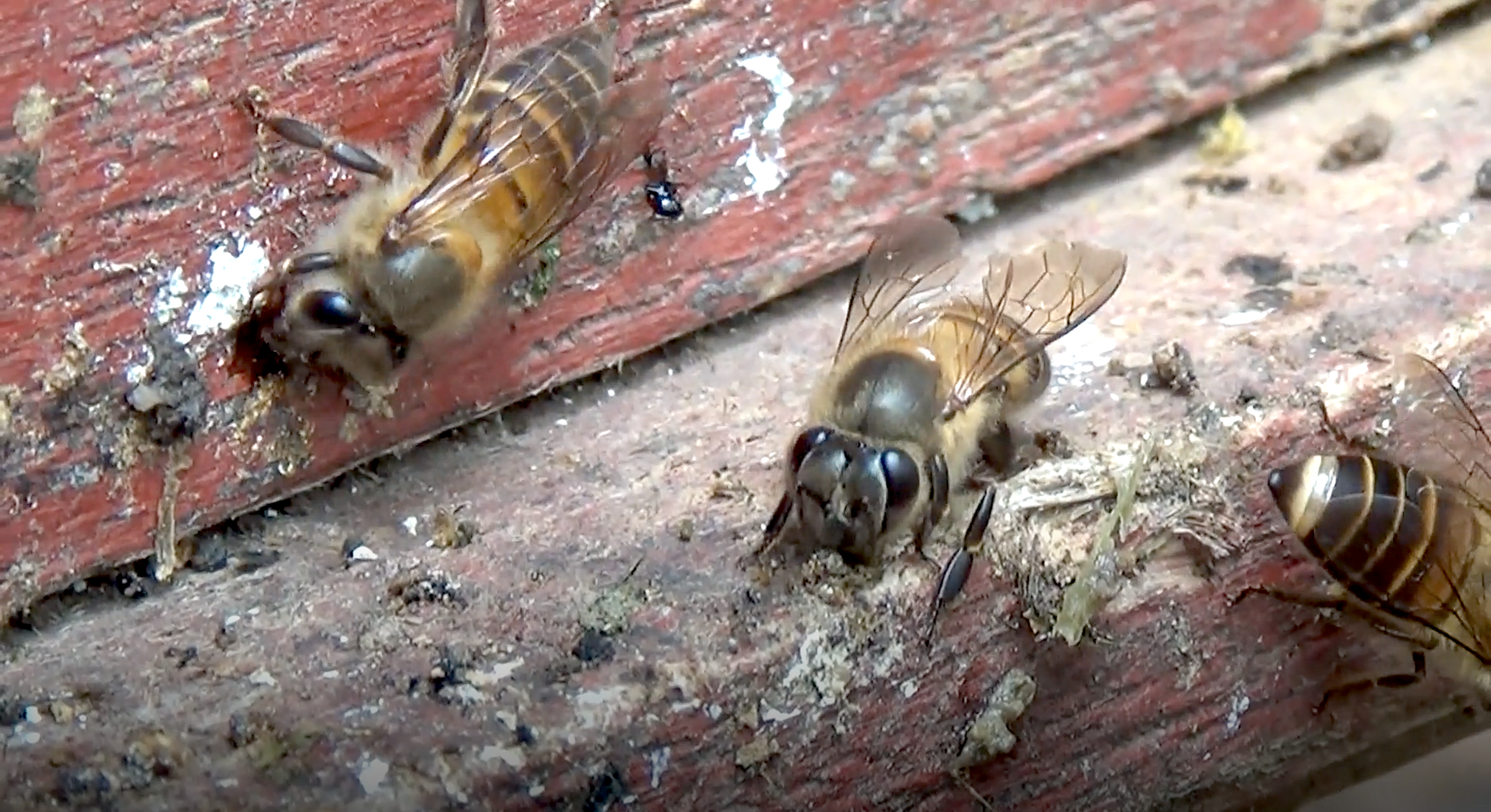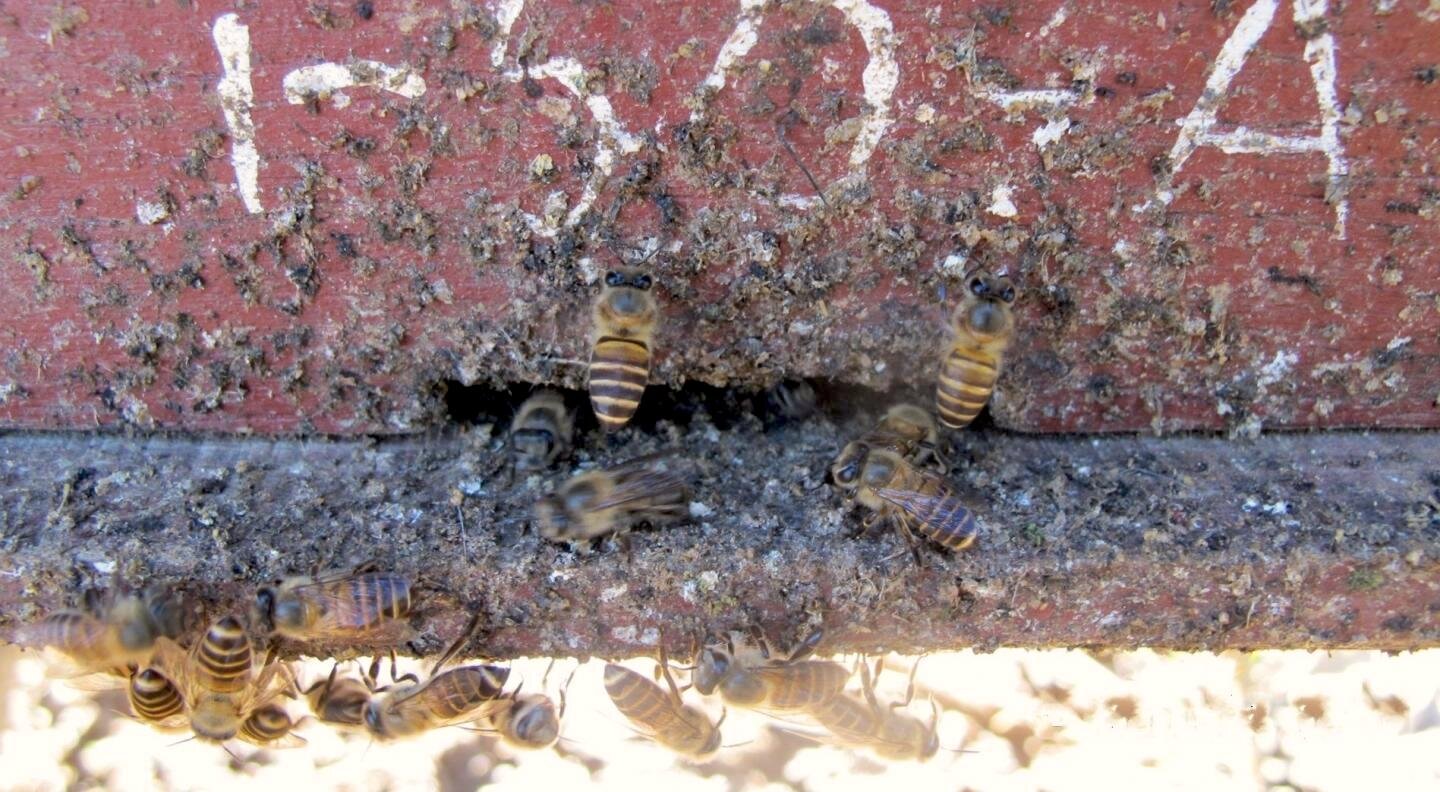2013 | Hanoi Province, Vietnam
Honey bee (Apis cerana) nest spotting
What’s your first reaction if I mention a giant hornet?
An involuntary shiver maybe, or a quick check that there’s nothing slowly buzzing and crawling up your shoulder? Perhaps a painful memory of that time you were shocked by the sudden heat of a hornet’s sting? Whatever your reaction, now imagine how you’d feel if you were only the size of a bee.
The heroes of today’s tool-use post don’t have to imagine that last bit. They really are honey bees, and they really are under regular attack from a fearsome predator: group-hunting giant hornets (Vespa soror). We’re in Vietnam, and to put it bluntly—but accurately—the s**t has hit the fan.
Spotting trouble
In Ba V`ı District, northwest of Hanoi, beekeepers manage hives that accommodate two honey bee (Apis cerana) colonies in one box. There’s an internal divider, and each colony has its own entrance to the wooden hive, via a thin slit near the base. The slit is less than a centimetre high, and a few centimetres wide, and it’s the only way for the bees to pass on their busy business to and from the hive.
Here’s one of those entrances with its little wooden front porch—and yes it’s a bit messy but we’ll get to that:
A key reason why the opening is so small is that honey bees aren’t the only ones trying to get in. These Asian bees co-evolved with a variety of dangerous predators, including those pesky giant hornets. If a nest is overrun and its bee occupants killed or dispersed, the hornets can raid it at their leisure, taking bee eggs and larvae (the brood) off to feed their own kin.
In nearby Japan, that co-evolution has led to a remarkable defence strategy on the bees’ behalf, in which a mass of honey bees will surround and envelope an invading hornet. And then literally turn up the heat. In the 1990s, scientists from Tamagawa University found that these bee balls, each of which contains hundreds of individuals working together, could generate an internal temperature of around 47 degrees Celsius, killing the hornet within 30-60 minutes.
That 47 degree level is critical. Just a few degrees more and the bees would also cook and die. And a few degrees less and the hornet would live, chopping off the heads of its attackers one by one. The defensive ruck seems to be triggered by release of a pheromone that recruits helper bees to the cause. The most dangerous time for attacks is the autumn, when group raids—described by the scientists as being a ‘slaughter phase’ following initial marking of a honey bee nest by a single scout hornet—intensify to supply extra protein for hornet reproduction.
But let’s return to Vietnam, where it’s also autumn, and (oh no!) some giant hornets have discovered a hive entrance. Compare this image to the one above and you’ll get an idea of the unfair difference in weight class for each of these insects:
It’s not as if having a restricted access policy is a sure guard against hornet intrusion, either. The same powerful mandibles that can snip off a honey bee’s head are also perfect for chipping and slicing away at the wood around the hive entrance, to open it up. That’s what those two central hornets above are doing, and the result is either impressive or deeply concerning, depending on which insect you’re supporting:
This particular attack happened at one of the Hanoi Province research sites being studied by Heather Mattila, of Wellesley College, and her colleagues in 2013. The scientists chased away those particular hornets before they could get inside, but I imagine that relentless scraping noises and huge shadows across a hive entrance are the subject of whatever nightmares honey bees may have.
So, what’s a bee to do? You can’t cook all the hornets, there are so many, intent on slaughter. And when you’re out of options, I guess it’s time to fight dirty.
Foul balls
From August to October 2013, Mattila and her team were guided by local apiculturalists to hives that were likely to be targeted by giant hornets. They noticed that these hives weren’t always the cleanest around the entrance, despite honey bees typically being meticulous about hive hygiene. The locals explained that this was a normal situation in those parts, and suggested the scientists watch where the bees go.
The researchers, including Vietnamese entomologists, watched carefully as marked honey bees made exploratory trips not only to fragrant flowers, but to nearby dungheaps. Pig droppings, chicken poop, water buffalo mess, the bees raided them all. As Mattila explained to Science magazine, the bees seemed to be quite picky, despite their unpleasant (to the researchers) task:
"It's like a flea market; they're sorting through the top of it, pulling at it," she says. "There was a real purpose in the search."
With their trash/treasure selected, each bee then returned to the hive, where they applied the collected matter in spots all round the entrance. This video from the subsequent research paper gives an idea of how it was done, resulting in that apparent mess we saw in the earlier image:
No scientists had ever recorded honey bees repeatedly bringing solid pieces of animal droppings—or any other animal pieces—back to their hives. They’re typically plant-based foragers. Was this just some aberrant activity, or did it have purpose? A logical explanation that made intuitive sense to the human researchers was that the bees were fouling their front door as a deterrent to predators, especially those enormous chewing wasps. But did the bees see it that way?
The first question the team had was whether or not the the bees were acting specifically in response to giant hornets, and perhaps even to certain hornet species. And it appears they were. The honey bees were a lot more active in their spotting behaviour when visited by Vespa soror, compared to the more solitary and smaller hornet Vespa velutina. The former, bigger hornet is four times as deadly to the bees, so the extra effort certainly seems justified.
By the same token, hives that the researchers kept free of hornets—using the sophisticated method of waving a plastic bag tied to a two-metre stick whenever any tried to drop in—had almost no poop spots, while those under attack rapidly accumulated a healthy covering. The bees continued to lay down their defensive doormat in the days following an attack, whether or not more hornets showed up on those days.
And because research is sometimes a bit mean, the team even tried applying a bit of the marking scent left by giant scout hornets to help guide their ‘slaughter phase’ friends. In that case, although real wasps were entirely absent, the bees still got to work on their fecal fortifications. Fortune favours the prepared hive.
Naturally though, being scientists, the team wasn’t happy to consider it case closed. They needed the hornets’ opinion too. Were the invaders as put-off by these sticky welcome mats as the scientists?
Yes again. The more spotting around an entrance, the less time a visiting hornet spent near that entrance. Further, if they did land, they spent less time before taking off again, and that hole-widening chewing behaviour dropped off as well. Attacks by multiple hornets showing up at the same time reduced significantly when a hive was moderately or heavily spotted, compared to lightly spotted ones. Giant killer hornets can’t help but be themselves though: a bee still ended up getting killed around 30% of the time a hornet showed up, regardless of the amount of surrounding excrement.
It’s still not clear exactly why the hornets were dissuaded, but scent markers are likely important here. It’s possible that chemicals in the dung itself repel the invaders, or perhaps the spots act as olfactory camouflage, masking the scent of the hive or earlier markings made by scout hornets. A deeper dung dive is needed in future studies.
Of course, there’s only one way to be absolutely sure that the hornets actually had malicious intent, and weren’t just looking for a nice place to hang out and chew wood. So the researchers allowed one hornet invasion to go ahead without plastic-bag-interference, with the inevitable result:
successful nest entry by V. soror was followed by rapid occupation of the nest and predation of bee brood (the surviving bees absconded), which is the well-known outcome of the damaging and often lethal attacks on honey bees.
Toilet tools?
Mattila and her colleagues argued that the spotting wasn’t just a matter of exterior decoration, it was actually tool use, the first recorded for honey bees. The apparently deliberate, manipulative, and goal-oriented (defensive) nature of the task all fit with common criteria for accepting a behaviour as part of the tool-use club.
Narrow definitions might insist that a tool should he held and wielded directly against some surface or object—in this instance the bees would need to be striking the hornets with the filth held in their mandibles. But that restricted definition can miss the value of animals manipulating and changing their environment using objects that don’t ever make direct contact with their target. That narrower view would also rule out the scientist’s plastic-bag-on-a-stick hornet deterrer, for example, unless it actually hit every deterred hornet as it was waved around. Even though the bag definitely changed the hornet behaviour in the intended way, it doesn’t need to have a direct mechanical effect on them to work. Does that make it not a tool?
A case could be—and no doubt will continue to be—made either way, but at this point in our exploration of animal technology, I see little point in being overly restrictive with definitions. If your aim is to work out the mechanical advantage of different types of hammer, then a narrow view that relies on direct physical contact has value. But if something like pheromones play a central role, then the fact that we as humans have trouble detecting them shouldn’t be an automatic reason to rule honey bee spotting out of the tool-use club.
Definitions aside, this story has current relevance. Asian giant hornets, specifically Vespa mandarinia, are just now beginning to invade North America. Their spread poses a very real risk to the unprepared European honey bees (Apis mellifera) farmed there. If beekeepers in Canada and the USA can gain some value from the Vietnamese bee tactics, perhaps by refining the chemical deterrent involved, or otherwise working out what it is that the hornets dislike, then we could even see a case of technological transfer from insect to (human) primate. At the very least—and this is a common refrain here I know!—it should encourage us to pay much more attention to our animal cousins, who are living extraordinary tool-assisted lives of peril and purpose that we are still only beginning to appreciate.
Sources: Mattila, H. et al. (2020) Honey bees (Apis cerana) use animal feces as a tool to defend colonies against group attack by giant hornets (Vespa soror). PLoS ONE 15:e0242668. || Ono, M. et al. (1995) Ono, M., Igarashi, T., Ohno, E., & Sasaki, M. (1995). Unusual thermal defence by a honeybee against mass attack by hornets. Nature, 377:334–336. || Stokstad, E. (2020) Giant hornets on the attack? Try a little water buffalo poop. Science https://www.science.org/content/article/giant-hornets-attack-try-little-water-buffalo-poop || Zhu, G. et al. (2020) Assessing the ecological niche and invasion potential of the Asian giant hornet. PNAS 117:24646-24648.
All image credits: Mattila et al. (2020) || Video credit: SciTech Daily; https://www.youtube.com/watch?v=c59r77QrHrA



